Decor
Crafting an Interior Design Contract: A Comprehensive Guide
Navigate the complexities of interior design contracts to unravel the secrets behind successful designer-client relationships.
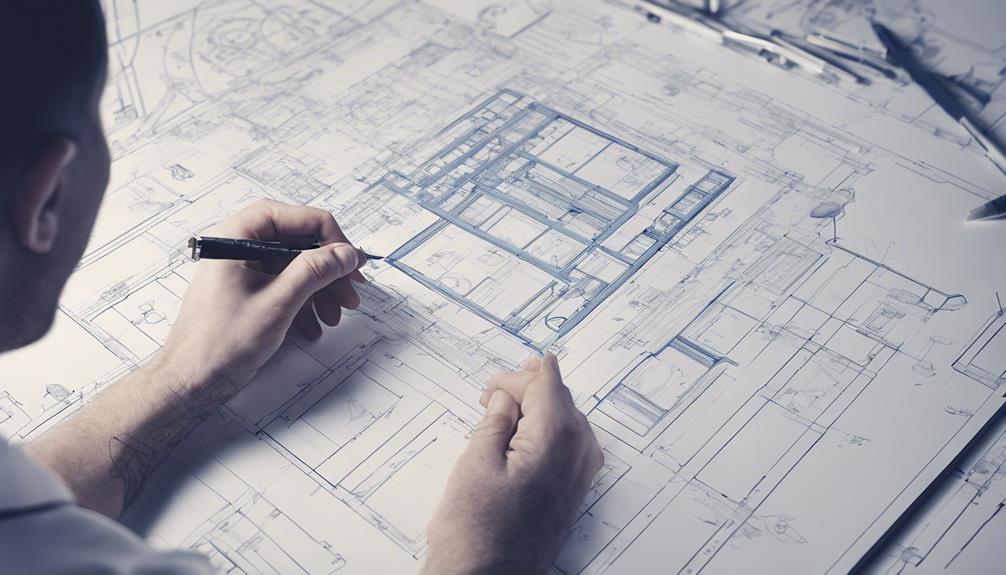
In the intricate dance of creating a well-crafted interior design contract, we must carefully consider every step as we lay the foundation for a successful partnership. As we navigate the labyrinth of legalities and intricacies involved, it becomes evident that a meticulously constructed contract is the cornerstone of a fruitful collaboration between designers and clients.
By exploring the nuances of each clause and the significance of detailed terms, we uncover the key to fostering mutual respect and understanding in the dynamic domain of interior design agreements.
Key Takeaways
- Clearly define project scope and structure for effective communication.
- Establish transparent payment terms to ensure financial clarity.
- Detail specific deliverables and milestones to track progress.
- Set realistic project timelines to maintain efficiency and accountability.
Key Components of Interior Design Contracts
When drafting interior design contracts, it's important to meticulously outline the key components that define the scope and structure of the project. The design contract for an interior design business should clearly articulate the scope of work, detailing all aspects of the design process, from initial concepts to final implementation.
Including pricing terms is vital, ensuring transparency on costs, payment schedules, and any mark-ups involved. Additionally, specifying insurance policies within the contract provides necessary protection for both parties involved, safeguarding against unforeseen circumstances.
Establishing a professional working relationship is paramount in the interior design industry. Contracts serve as a roadmap, guiding the designer and client through the project with clear expectations and boundaries. By incorporating legal protection within the contract, potential disputes can be minimized, and all parties can proceed with confidence. It's advisable to have a legal expert review the contract to ensure thorough coverage and adherence to industry standards.
Establishing Payment Terms and Conditions

Establishing clear and thorough payment terms and conditions is critical in an interior design contract to guarantee transparency and financial clarity throughout the project. When outlining design fees, make certain the total amount, hourly rate, and deposit are explicitly defined. Specify accepted forms of payment, the payment schedule, and any late fees for overdue payments to maintain a smooth financial process. Address reimbursable expenses related to the project, detailing how they'll be managed.
Including refund and cancellation policies, along with any applicable return fees, is vital. Integrate clauses for potential industry price fluctuations within the payment terms to provide a Price Guarantee for both parties. Ensure the client agrees to these terms to avoid misunderstandings.
Furthermore, consider including information on insurance coverage to protect all parties involved. Crafting a detailed payment section in your interior design contracts sets the foundation for a successful and transparent working relationship.
Defining Scope of Work and Deliverables
How do we precisely define the scope of work and deliverables for an interior design project to guarantee clarity and successful outcomes? When outlining the scope of work and deliverables for an interior design project, it's crucial to be detailed and specific to avoid misunderstandings or scope creep.
Here are key steps to ensure clarity and successful project completion:
- Define the Scope of Work: Detail specific tasks and responsibilities involved in the project.
- Specify Deliverables: Outline tangible outcomes or results expected from the design process.
- Clarify Design Elements: Identify furniture selection, color schemes, lighting plans, and spatial layouts.
- Establish Project Milestones and Deadlines: Set clear timelines to track progress and make sure tasks are completed on time.
Setting Clear Project Timelines

Setting clear project timelines requires meticulous planning and strategic scheduling to guarantee timely completion and successful outcomes. It's indispensable to clearly define project start and end dates at the onset of the interior design contract. By specifying milestones and deadlines for different project phases, progress can be effectively tracked. Including buffer time in the timeline allows room for unexpected delays or changes in the design process without compromising the overall schedule.
Emphasizing the importance of adhering to the established timeline is vital for maintaining project efficiency. Clients need to understand the consequences of timeline extensions or delays, as they can have a direct impact on project costs and schedules. Communicating these factors transparently helps in fostering a collaborative approach towards meeting project deadlines and achieving desired results.
Addressing Client Responsibilities
To guarantee a smooth and efficient interior design process, it's important to clearly outline the responsibilities expected from the client. When addressing client responsibilities in an interior design contract, there are several key aspects to take into account:
- Client Responsibilities for Design Drawings: Clients should be responsible for obtaining necessary permits and providing accurate information to make sure the creation of precise design drawings.
- Approvals for Custom Pieces: Clients need to fulfill obligations related to approvals for custom pieces and furnishings, including Cuttings For Approval (CFAs), to maintain design integrity.
- Financial Transactions: Informing clients about processing fees, non-refundable items, and the handling of cancellations, refunds, and disputes is important for transparent financial transactions.
- Project Boundaries and Client Involvement: Establishing boundaries for client involvement during the project is crucial to maintain a structured workflow and facilitate clear communication channels throughout the design process.
Frequently Asked Questions
How Do You Make an Interior Design Contract?
We outline project scope, payment terms, design rights, and termination clauses. Our contract includes provisions for design ownership, purchasing responsibilities, and price fluctuations. We address termination options, photography permissions, and contractor responsibilities.
What Are the Key Elements of Interior Design Building Contract?
We guarantee a thorough interior design building contract by focusing on key elements: project scope clarity, precise payment terms, safeguarding ownership and design rights, following purchasing guidelines, and outlining termination clauses. Let's craft an innovative contract together.
How to Start an Interior Design Business the Complete Guide?
Starting an interior design business involves creating a strategic plan, researching competitors, registering the business, setting up a workspace, establishing an online presence, and networking with industry professionals. These steps are essential for launching a successful venture.
What Is Comprehensive Interior Design?
Thorough interior design merges functionality and aesthetics to craft spaces that harmoniously reflect clients' needs. It weaves together layout, colors, furniture, and decor to create seamless environments that embody personal style.
Conclusion
To sum up, crafting an interior design contract is like laying the foundation for a beautiful and sturdy structure. By carefully outlining the scope of work, establishing clear payment terms, and setting project timelines, both designers and clients can build a successful partnership.
Just as a skilled architect plans every detail of a building, interior designers must meticulously craft contracts to make sure a smooth and harmonious design process.
- About the Author
- Latest Posts
Introducing Ron, the home decor aficionado at ByRetreat, whose passion for creating beautiful and inviting spaces is at the heart of his work. With his deep knowledge of home decor and his innate sense of style, Ron brings a wealth of expertise and a keen eye for detail to the ByRetreat team.
Ron’s love for home decor goes beyond aesthetics; he understands that our surroundings play a significant role in our overall well-being and productivity. With this in mind, Ron is dedicated to transforming remote workspaces into havens of comfort, functionality, and beauty.
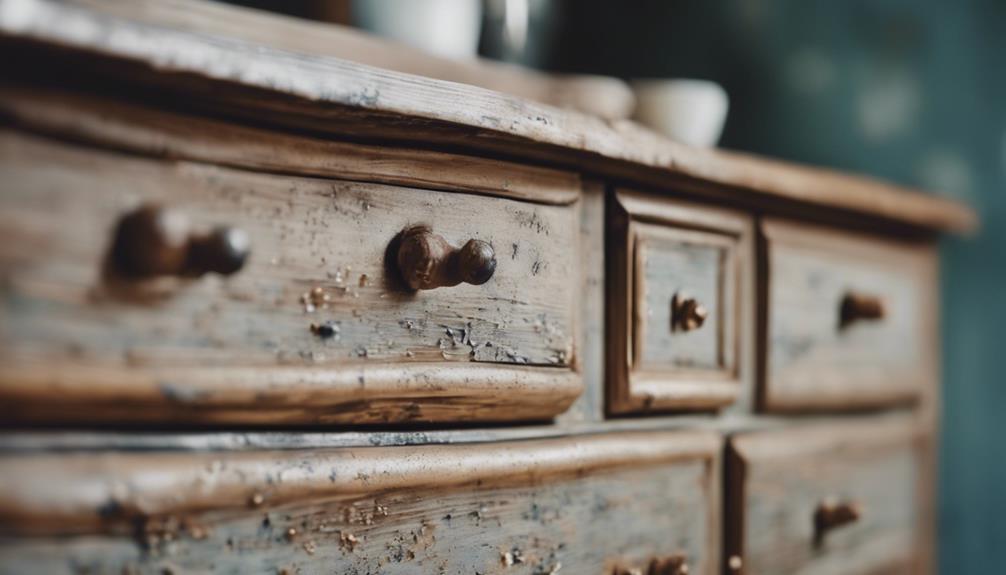
Repurposing an old dresser demands precision and care. Remove drawers with caution, noting mechanisms and hardware. Craft a bench seat and back thoughtfully, using quality materials. Sand meticulously for a flawless finish. Opt for high-quality paint and stain, applying thin, even coats. Style your bench creatively for functionality. Guarantee accurate measurements when cutting to size. Select primers and finishes wisely for long-lasting results. If you seek to access the complete step-by-step guide, further insights await.
Key Takeaways
- Use quality tools for precision cuts and smoother finishes.
- Safely remove drawers by following specific instructions.
- Measure accurately and shape wood pieces for the bench.
- Sand dresser thoroughly for a professional paint finish.
- Apply primer and finishing coats for durability and aesthetic appeal.
Tools and Materials Needed
To begin repurposing an old dresser, we'll need a set of essential tools and materials for the transformation process. Key tools include a jigsaw, reciprocating saw, hammer, sander, skill saw, or table saw, finish nailer, and Rapid Fuse. These tools are vital for dismantling the dresser, creating new components, sanding, painting, and finishing the repurposed piece.
Additionally, materials such as bead board for support or replacing wood may be required during the transformation. Proper utilization of these tools guarantees a successful and professional-looking outcome when repurposing the old dresser into a new functional item.
Investing in quality tools and materials will make the project more manageable and efficient, resulting in a beautifully transformed piece of furniture. Remember, having the right tools at your disposal is the first step towards a successful dresser repurposing project.
Removing Dresser Drawers
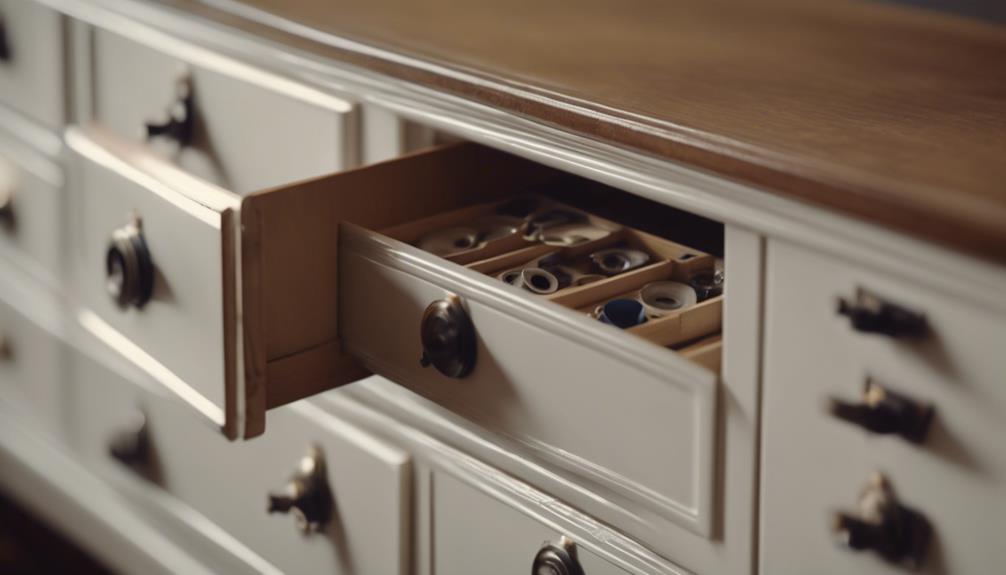
When removing dresser drawers, one must first clear out any items inside and make sure there are no obstructions blocking the way.
Locating the drawer stop mechanism is important, as it varies in form and design from dresser to dresser. Following the specific instructions for your particular model is essential to safely release the drawer stops and extract the drawer without causing damage.
Drawer Removal Techniques
We start by fully extending each drawer until it reaches its stopping point.
When removing dresser drawers, it's important to look for release mechanisms such as tabs or levers located on the drawer slides. These mechanisms allow you to disconnect the drawers from the dresser easily.
Keep an eye out for hidden screws or clips that may be securing the drawers in place; these will need to be removed before you can successfully take out the drawer.
Remember to proceed with caution, especially with heavy or stuck drawers, to prevent any injuries or damage to the dresser.
It's advisable to keep track of all hardware and screws as you disassemble the drawers to simplify the reassembly process later on.
Tools Needed for Removal
For removing dresser drawers, having the right tools available is essential for a smooth and efficient process. Utilizing a jigsaw and reciprocating saw can greatly facilitate the removal of drawers, especially for cutting through stubborn components. These tools provide the precision and power needed to disassemble the drawers effectively.
In some cases, a hammer might be necessary to aid in separating tightly joined parts. Additionally, consider using a sander to smooth out any rough edges left behind after the removal process, ensuring a clean finish.
For those seeking even more accuracy in cutting, a skill saw or table saw could be advantageous. When it comes to reassembly or repairs post-removal, having a finish nailer and Rapid Fuse adhesive on hand can be beneficial for securing components back in place. By having these tools ready, the task of removing dresser drawers can be accomplished with greater ease and efficiency.
Safety Precautions During Removal
Having the appropriate tools for removing dresser drawers is vital to guarantee a safe and efficient process. When working with an old dresser, it's crucial to take safety precautions to prevent accidents.
To begin with, make sure the drawers are empty before attempting to remove them, as contents inside can shift and cause instability. Use caution when pulling out the drawers to avoid injuries from falling or sliding drawers. Maintain a firm grip on the handles or sides of the drawers to have better control over the removal process.
Before handling the drawers, inspect them for any sharp edges or protruding nails that could potentially harm you during removal. Additionally, work in a well-lit area to clearly see and navigate the removal process safely.
Creating Bench Seat and Back

To craft the bench seat and back for your repurposed dresser, accurately measure and cut wood pieces based on the dresser's dimensions. When creating the bench seat, it's important to ensure stability and comfort.
Here's how to proceed:
- Use a jigsaw or reciprocating saw to shape the wood pieces for the bench seat according to your desired design.
- Add bead board or additional wood pieces for back support, ensuring a sturdy and reliable structure.
- Always double-check the measurements to guarantee a perfect fit within the dresser frame.
Sanding Techniques
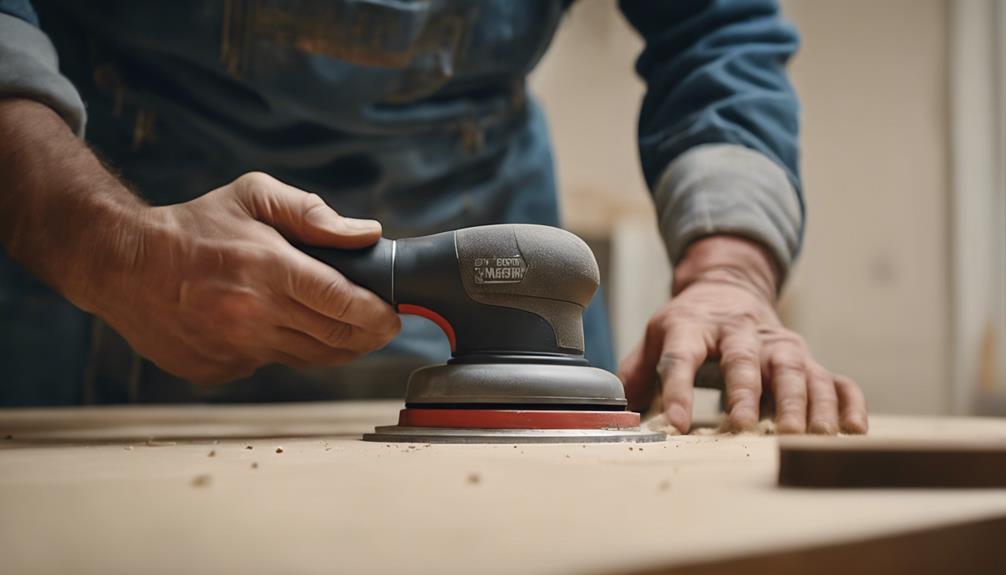
Sanding an old dresser is an essential step in the refinishing process to achieve a smooth and flawless surface. Proper sanding helps remove old paint, stains, and imperfections, revitalizing the look of the furniture. To effectively sand an old dresser, start with coarse sandpaper to strip away the existing finish. Progress to finer grits gradually to ensure a polished result. Using a sanding block or an electric sander can make the job more efficient and provide a consistent finish across the entire piece. Pay close attention to details such as corners, edges, and intricate designs to achieve a professional outcome. Thorough sanding prepares the dresser for painting, staining, or sealing, ensuring a durable and aesthetically pleasing final product.
| Sanding Tips | Description |
|---|---|
| Start Coarse | Strip away old finish effectively. |
| Progress to Finer | Achieve a smooth and polished surface. |
| Focus on Details | Pay attention to corners, edges, and intricate designs for a professional finish. |
Painting and Staining Tips
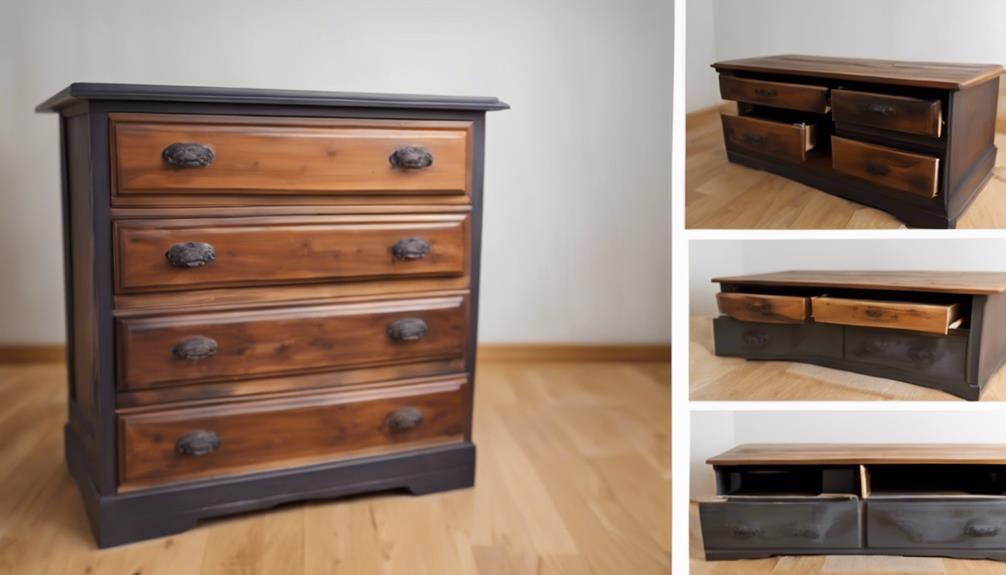
For achieving a professional finish, it's important to carefully select high-quality paint and stain specifically formulated for furniture.
When starting on a DIY project like repurposing an old dresser, following these painting and staining tips can help you achieve a flawless transformation:
- Choose the Right Products: Opt for paint and stain that are designed for use on furniture to guarantee durability and longevity of the finish.
- Apply Thin Coats: To avoid drips and achieve a smooth finish, apply multiple thin coats of paint or stain, allowing each layer to dry completely before proceeding.
- Consider Priming: Using a primer before painting can enhance color coverage and adhesion, particularly beneficial for dark or glossy surfaces.
Following these steps in your DIY project won't only result in a beautifully refurbished dresser but also make sure that your hard work lasts for years to come.
Styling the Finished Bench

We can enhance the visual appeal and functionality of the finished bench by creatively styling it in various spaces within our home. The versatility of the repurposed dresser allows us to incorporate it into our decor in multiple ways. Here are some ideas for bench styling and functional storage:
| Styling Ideas | Functionality |
|---|---|
| Use as shoe storage in a mudroom | Provides organized and stylish storage for footwear |
| Place in the front entryway | Combines seating and storage space for a practical and aesthetic entry |
| Create a cozy reading nook in a little girl's room | Adds charm and functionality for a comfortable space |
| Display and store treasures on the bench | Adds a decorative element to any room while providing functional storage |
Cutting Down for Bench Size
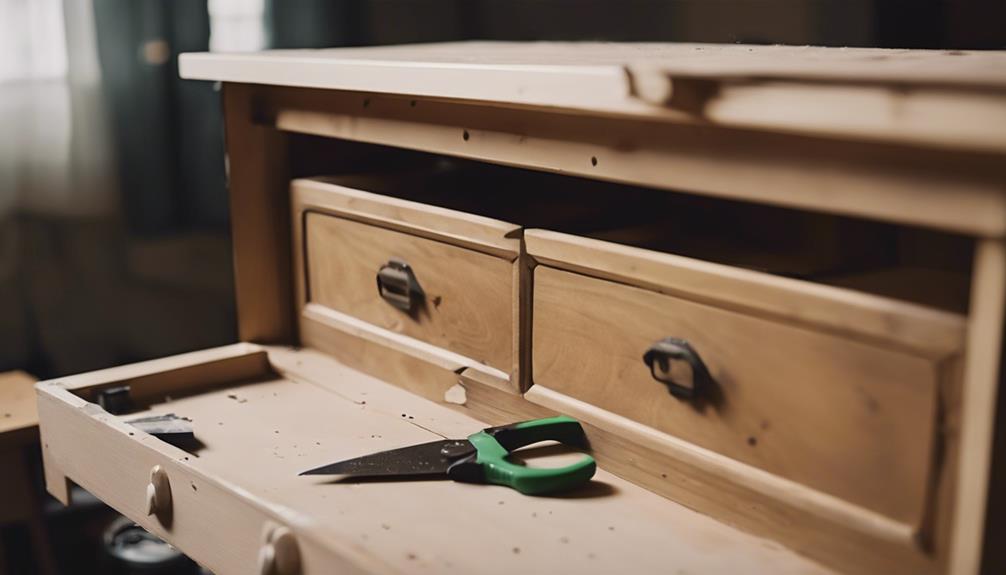
To achieve the desired bench size, we need to accurately measure and mark the dresser before making the necessary cuts. Here are some key steps to follow:
- Measure Twice: Before cutting down the dresser to the bench size, double-check all measurements to guarantee accuracy and avoid mistakes.
- Use the Right Tool: Opt for a jigsaw or reciprocating saw to make the cuts, guaranteeing precision and ease of maneuverability during the process.
- Maintain Evenness: When cutting the dresser to transform it into a bench, make sure that the cuts are straight and even for a polished and professional finish.
Priming and Finishing Coats
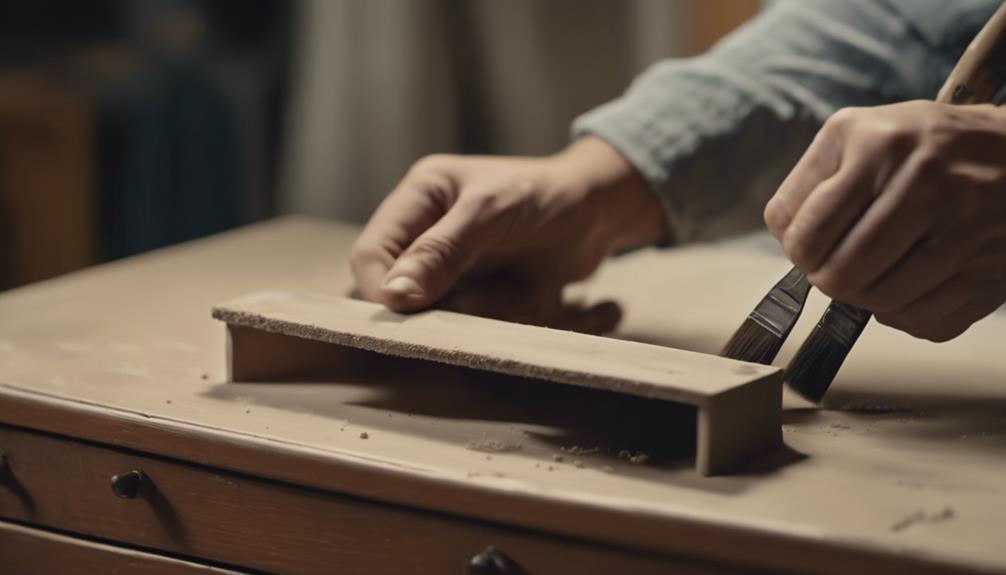
Applying a primer coat is essential to guarantee that the paint adheres properly to the dresser's surface, creating a solid foundation for the finishing coats. Make sure to select a high-quality primer that matches the material of the dresser, such as wood or laminate, for best results.
Additionally, finishing coats not only safeguard the dresser from daily wear and tear but also provide a lasting and resilient finish, enhancing the overall appearance of the repurposed piece.
Surface Preparation
Proper surface preparation for repurposing an old dresser involves sanding, priming, and applying finishing coats to guarantee a professional and durable finish.
Here are essential steps for surface preparation:
- Sanding: Begin by thoroughly sanding the dresser to remove any existing paint or finishes. This process creates a smooth surface for the new coats of paint or stain to adhere to effectively.
- Priming: After sanding, apply a layer of primer to the dresser. Priming helps the new finish adhere better to the surface and provides a more even base for the color application, ensuring a consistent and long-lasting result.
- Finishing Coats: Finally, applying finishing coats like varnish or sealant is vital. These coats not only enhance the aesthetic appeal of the dresser but also protect it from wear and tear, increasing the longevity of the repurposed piece.
Paint Application
For optimal results in painting an old dresser, we recommend starting with a high-quality primer to guarantee paint adhesion and durability. Priming is vital when refurbishing furniture pieces to create a smooth and long-lasting finish. Choose a primer specifically designed for use on furniture to ensure proper adhesion and prevent the paint from chipping or peeling over time.
When applying paint to the dresser, it's essential to use multiple thin coats rather than one thick layer. This approach allows for better coverage and a smoother finish. Confirm that each coat is fully dry before applying the next to avoid any unevenness or bubbling in the paint.
Consider using a paint sprayer for a more even and professional-looking application. However, if a paint sprayer isn't available, a high-quality paint brush or roller can also achieve a consistent and smooth finish on the dresser.
To enhance the longevity of the paint and protect the surface, finish the dresser with a clear protective coat. This final step will seal the paint and provide an extra layer of durability against daily wear and tear.
Frequently Asked Questions
How to Turn an Old Dresser Into Something New?
When considering how to turn an old dresser into something new, it's crucial to evaluate its condition and style. Sanding, painting, and adding new hardware can revitalize the dresser.
Repurposing the existing structure creatively guides the transformation process. This approach breathes new life into the furniture and allows for a personalized touch in your living space.
Careful planning and attention to detail are key in achieving a successful and unique outcome.
How Do You Make an Old Wooden Dresser Look Modern?
To make an old wooden dresser look modern, we suggest painting it with a trendy color like navy blue or blush pink. Swapping out the old hardware for sleek, contemporary drawer pulls can instantly update its look.
Adding geometric or abstract designs with paint or wallpaper can give it a fresh, modern vibe. Incorporating metallic accents like gold or silver spray paint can also bring a touch of glamour to the dresser.
Consider embracing a minimalist or Scandinavian design style for a clean, modern aesthetic.
How to Refurbish a Wooden Dresser?
When refurbishing a wooden dresser, begin by sanding down the surface to remove old paint and create a smooth base.
Address any structural issues like loose joints before applying a high-quality wood stain or paint for a fresh appearance.
Consider updating the hardware for a modern touch.
Finish by applying a clear protective coat to prolong the dresser's longevity.
Following these steps will guarantee a successful refurbishment of a wooden dresser.
How to Repurpose Old Drawers?
When looking to repurpose old drawers, we've found various creative solutions. Convert them into storage bins for small items like jewelry, craft supplies, or office supplies.
Alternatively, consider transforming them into wall shelves by adding brackets, creating a unique display option.
For a touch of greenery, repurpose drawers as planters, offering an eco-friendly gardening alternative.
Don't forget about your furry friends – repurpose drawers into pet beds by adding cushions.
The possibilities are endless!
Conclusion
To sum up, repurposing an old dresser into a beautiful bench is a rewarding DIY project that can breathe new life into your space.
Just like a caterpillar transforms into a butterfly, your dresser can undergo a stunning metamorphosis with a little creativity and effort.
So grab your tools and get started on your own transformation journey today!
- About the Author
- Latest Posts
Introducing Ron, the home decor aficionado at ByRetreat, whose passion for creating beautiful and inviting spaces is at the heart of his work. With his deep knowledge of home decor and his innate sense of style, Ron brings a wealth of expertise and a keen eye for detail to the ByRetreat team.
Ron’s love for home decor goes beyond aesthetics; he understands that our surroundings play a significant role in our overall well-being and productivity. With this in mind, Ron is dedicated to transforming remote workspaces into havens of comfort, functionality, and beauty.
Mardi Gras Decoration
How Do You Make a Floating Paper Lantern?
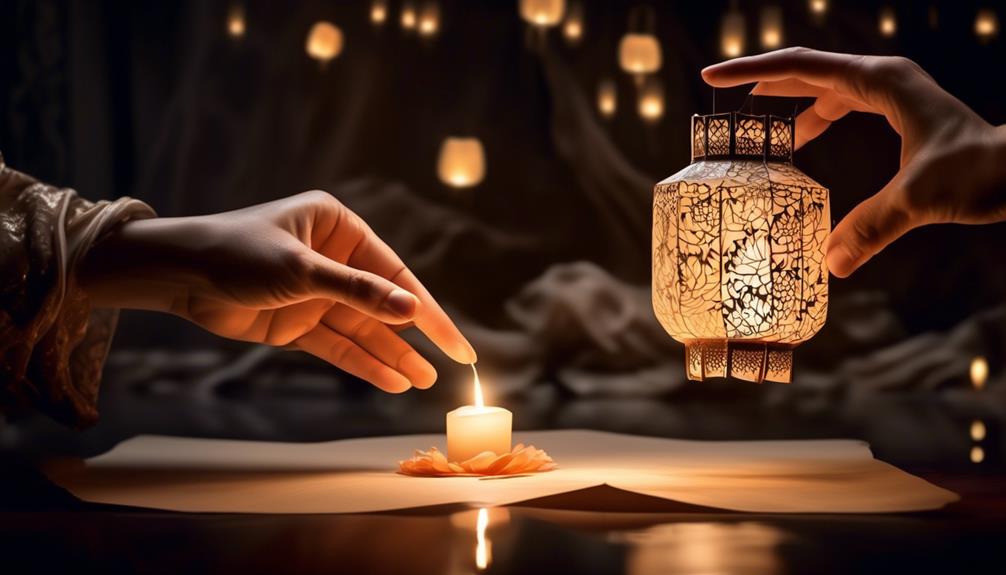
Have you ever been to a festival where you witnessed the stunning sight of floating paper lanterns lighting up the night sky?
Have you ever wondered how they're made and how you can create one yourself?
Making a floating paper lantern is a fascinating and rewarding experience, but it requires attention to detail and a few key techniques.
If you're interested in learning the art of crafting these mesmerizing creations, we have just the guide for you.
Key Takeaways
- Lightweight and flame-resistant paper, such as rice paper or tissue paper, is essential for making a floating paper lantern.
- Incorporate meaningful symbols or motifs in the design of the lantern to add a personal touch.
- Use adhesive and small fasteners to attach the frame, choosing lightweight yet sturdy materials.
- Enhance the lantern's visual appeal by adding decorative elements such as glitter, ribbons, markers, and adhesive gems.
Choosing the Right Paper
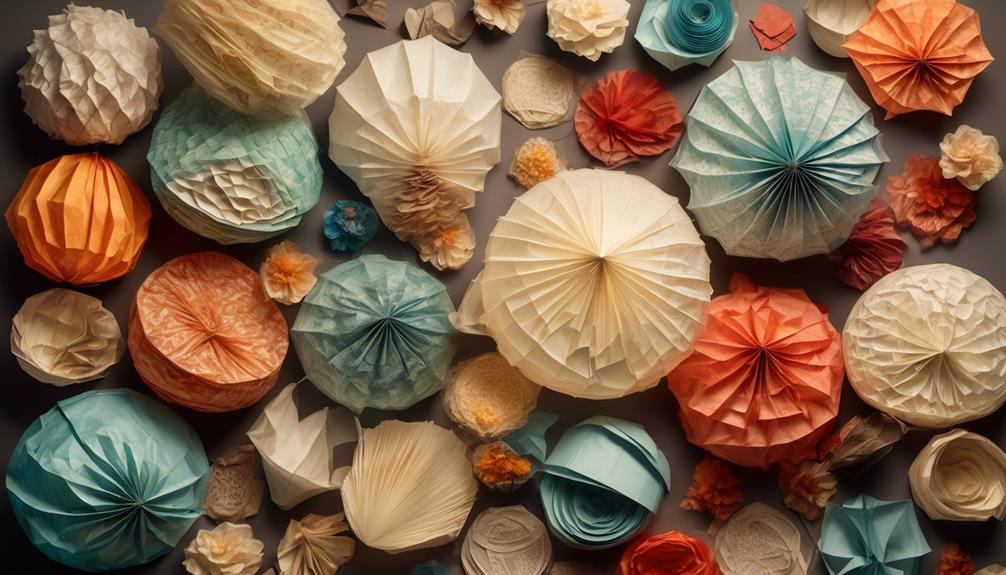
When making a floating paper lantern, it's vital to select a paper that's both lightweight and flame-resistant. The paper quality is crucial for the durability and safety of the lantern. We found that rice paper or tissue paper works best due to its lightweight nature and flame-resistant properties. These papers are sturdy enough to hold their shape when the lantern is assembled and provide a beautiful glow when the candle is lit inside.
As for color options and aesthetics, there are numerous choices to consider. The color of the paper can significantly affect the ambiance and visual appeal of the lantern. From vibrant and bold hues to soft pastel shades, the color options are endless. Some may prefer a traditional look with white or off-white paper, while others may opt for a more colorful and eye-catching lantern.
Additionally, consider the translucency of the paper as it can influence the way the light shines through, creating a mesmerizing effect.
Designing Your Lantern
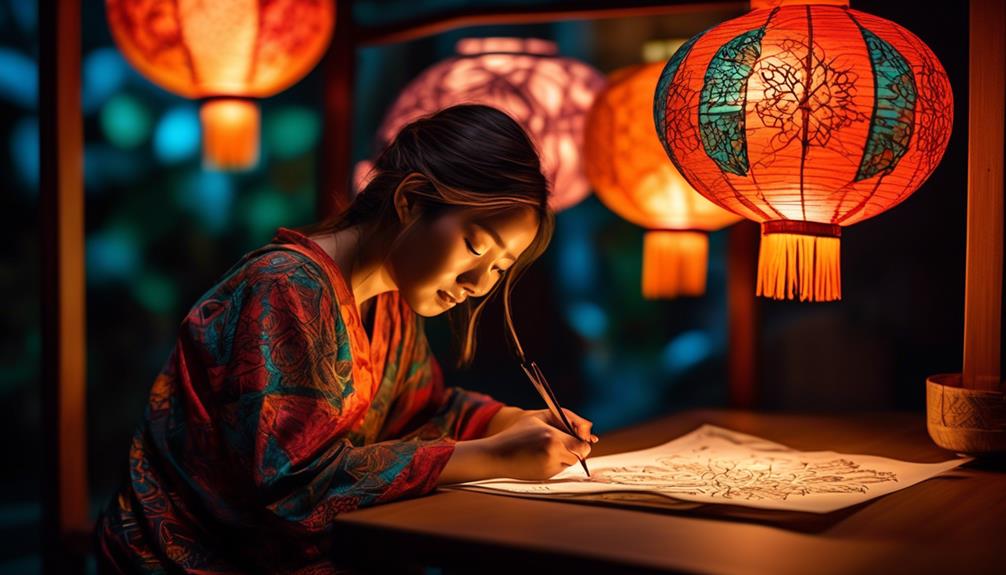
To design your lantern, consider incorporating meaningful symbols or personal motifs to enhance its visual impact and emotional significance. Lantern customization allows for a personalized touch, making it a unique reflection of individuality. Here are some tips to guide you through the designing process:
- Reflect on Meaning: Choose symbols or motifs that hold personal significance, such as a favorite quote, a meaningful date, or a representation of a cherished memory. Infusing your lantern with personal meaning adds depth and emotional resonance.
- Embrace Creativity: Let your imagination run wild and explore various design possibilities. Incorporate colors, patterns, and imagery that resonate with your personal style and aesthetic preferences.
- Consider Practicality: While focusing on creativity, ensure that your design allows for the practical aspects of constructing a floating paper lantern. Consider the placement of symbols and motifs to ensure they don't interfere with the structural integrity of the lantern.
- Test and Refine: Before finalizing your design, consider creating a prototype to test its visual impact and functionality. This allows for adjustments and refinements to ensure that your lantern reflects your vision effectively.
Designing your own lantern is a deeply personal and rewarding process, allowing you to infuse a simple paper structure with your unique personality and creativity.
Attaching the Frame
Let's start by discussing the technique for attaching the frame to the paper lantern.
We'll also cover the materials needed for constructing a sturdy and reliable frame.
Additionally, we'll explore effective methods for securing the frame in place to ensure the stability of the lantern.
Frame Attachment Technique
We securely fasten the frame to the paper lantern using a combination of adhesive and small, discreet fasteners. This ensures that the frame remains securely in place, providing stability and support for the lantern.
Here are some key techniques we use for attaching the frame:
- Adhesive Application: We carefully apply a strong, weather-resistant adhesive along the edges of the frame to create a firm bond with the paper lantern.
- Strategic Fastener Placement: We strategically place small fasteners at key points on the frame to reinforce its attachment to the lantern without compromising its appearance.
- Even Distribution: We ensure an even distribution of adhesive and fasteners around the frame to maintain its structural integrity.
- Final Inspection: We meticulously inspect the attachment points to guarantee that the frame is securely and evenly attached to the paper lantern.
Materials for Frame
After securely fastening the frame to the paper lantern using a combination of adhesive and small, discreet fasteners, the next crucial step is to select the appropriate materials for ensuring a durable and reliable attachment. When considering frame construction, it's essential to choose materials that are lightweight yet sturdy. We recommend using bamboo or lightweight wooden dowels for the frame, as they provide the necessary support without adding excessive weight to the lantern. Additionally, supportive materials such as strong adhesive tapes, nylon threads, or small zip ties can be used to reinforce the frame's attachment to the paper. Here's a helpful table outlining the suggested materials for frame construction and reinforcement:
| Frame Construction | Supportive Materials |
|---|---|
| Bamboo | Strong adhesive tapes |
| Lightweight dowels | Nylon threads |
| Small zip ties |
Securing Frame in Place
To secure the frame in place, carefully align the attachment points with the designated areas on the paper lantern. Ensuring frame stability is crucial for the lantern's overall integrity. Here are some anchoring techniques to help secure the frame effectively:
- Twine or String: Use strong twine or string to tie the frame securely to the designated attachment points on the lantern.
- Adhesive Tape: Apply strong adhesive tape to firmly fix the frame in place, ensuring it remains stable.
- Clips or Clamps: Utilize clips or clamps to secure the frame tightly to the designated areas, providing additional stability.
- Staples: For a more permanent attachment, carefully use staples to secure the frame in place, ensuring it withstands external forces.
These techniques will help maintain the stability of the frame, ensuring the paper lantern is securely assembled for floating.
Adding Decorative Elements

Let's talk about the fun part – adding decorative elements to our floating paper lantern!
We'll cover the materials you can use for decoration, different techniques for embellishing your lantern, and how to make color and texture choices that will make your lantern stand out.
It's time to get creative and make our lanterns truly unique!
Materials for Decoration
We can enhance the beauty of the floating paper lantern by incorporating decorative elements such as glitter, ribbons, and colorful markers. Here are some materials for decoration to make your paper lantern truly stand out:
- Glitter: Add a touch of sparkle by using glitter glue or loose glitter to create dazzling patterns or accents on the lantern.
- Ribbons: Attach colorful ribbons to the bottom of the lantern to create a flowing and elegant effect when the lantern is floating on the water.
- Colorful Markers: Use vibrant markers to draw intricate designs, patterns, or meaningful messages on the lantern to personalize it.
- Adhesive Gems: Consider using adhesive gems to add a touch of elegance and glamour to your paper lantern.
These materials offer endless possibilities for creativity and personalization, allowing you to make a truly unique and beautiful floating paper lantern.
Techniques for Embellishment
Enhancing the aesthetic appeal of the floating paper lantern can be achieved through various techniques for embellishment.
When it comes to embellishing your paper lantern, the possibilities are endless.
One creative idea is to use intricate paper cutting techniques to add delicate designs to the lantern. This can be done by carefully cutting out patterns or shapes from colored paper and then adhering them to the surface of the lantern.
Another popular embellishment technique is the use of decorative elements such as glitter, sequins, or beads to add a touch of sparkle and glamour to the lantern.
Additionally, painting the lantern with vibrant colors or using calligraphy to inscribe meaningful phrases can also elevate its visual appeal.
These embellishment techniques allow for personalization and creativity, making each floating paper lantern a unique and beautiful creation.
Color and Texture Choices
When considering color and texture choices for adding decorative elements to your floating paper lantern, it's important to select materials that complement the overall design and ambiance you wish to create. Here are some key considerations:
- Color Choices: Opt for colors that align with the theme of your event or the mood you want to convey. Bright, vibrant colors can create a festive atmosphere, while pastel shades may evoke a sense of tranquility.
- Paper Texture: Choose paper with a delicate texture to create an elegant and refined look. Alternatively, textured paper can add depth and visual interest to your lantern.
- Contrasting Elements: Consider incorporating contrasting colors or textures to make certain decorative elements stand out and create visual appeal.
- Weather Resistance: If you plan to use the lantern outdoors, ensure that the colors and textures are resistant to weather conditions to maintain their beauty.
Assembling the Lantern
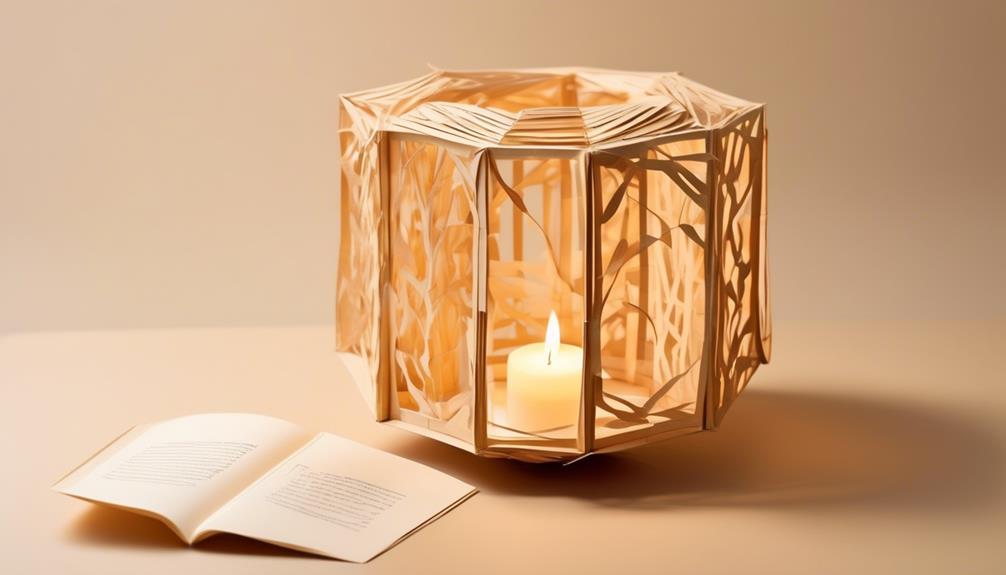
Using a clear adhesive, attach the edges of the paper lantern together to form a cylindrical shape. This step is crucial for ensuring that the lantern holds its shape and provides a sturdy base for the rest of the assembly process. Once the cylindrical shape is formed, gently secure the bottom of the lantern by affixing a circular piece of sturdy paper or cardboard. This will help to stabilize the lantern and provide a surface for the lantern lighting.
In terms of safety measures, it's important to use flameless LED candles or other battery-operated light sources for illuminating the lantern. Avoid using open flames, as they can pose a fire hazard, especially when the lantern is airborne. Additionally, when assembling the lantern, make sure to work in a well-ventilated area and keep any flammable materials away from the assembly space.
Assembling the lantern is an important part of the process, and taking the time to do it carefully will ensure that your floating paper lantern is both beautiful and safe for use.
Preparing the Fuel Source

With the lantern assembled and ready, the next step involves preparing the fuel source for the paper lantern. Ensuring fuel safety is crucial to avoid accidents and enjoy a worry-free experience. Here's how we prepare the fuel source:
- Choose the right fuel: Opt for a clean-burning, liquid fuel that's specifically designed for lanterns. Avoid using flammable substances or fuels that produce excessive smoke.
- Fill the reservoir carefully: Use a funnel to pour the fuel into the lantern's reservoir. Avoid overfilling to prevent spills and maintain flame control.
- Check for leaks: Before igniting the lantern, carefully inspect for any fuel leaks around the reservoir or wick. Address any leaks before proceeding.
- Ignite the lantern safely: Use a long-reach lighter or a fireplace match to ignite the lantern. Maintain flame control by adjusting the wick to achieve the desired brightness.
Igniting the Lantern

Let's get the lantern glowing by safely igniting the fuel source using a long-reach lighter or a fireplace match. Now that the lantern is prepped and the fuel source is ready, it's time to light it up. Before we delve into the process, it's crucial to emphasize fire safety. Always have a fire extinguisher or bucket of water nearby, and ensure the lantern is lit in an open, outdoor area away from any flammable materials. It's also important to be mindful of cultural significance when igniting the lantern. For many, this act holds deep cultural and spiritual importance, so approach it with reverence and respect.
Here's a simple guide to safely ignite the lantern:
| Steps | Instructions | Tips |
|---|---|---|
| Step 1 | Hold the lantern securely and upright. | Ensure the lantern is stable and upright. |
| Step 2 | Use a long-reach lighter to ignite the fuel. | Avoid leaning over the lantern while lighting. |
| Step 3 | Wait for the lantern to heat up and take flight. | Observe the lantern as it begins to rise. |
| Step 4 | Release the lantern once it's fully lit. | Enjoy the mesmerizing sight as it ascends. |
Launching Your Creation

Now that the lantern is aglow, it's time to release it into the night sky, creating a breathtaking and symbolic display. Before launching your creation, consider these important aspects:
- Sky Lantern Release: Find a spacious, open area away from buildings, trees, and dry vegetation. Ensure that there are no overhead obstructions or windy conditions. The ideal setting is a calm, clear night with minimal wind, allowing your lantern to gracefully ascend into the sky.
- Cultural Significance: Understand the cultural and spiritual significance of releasing sky lanterns. This act is often considered a symbol of good luck, hope, and positive intentions. Take a moment to reflect on the symbolism before releasing your lantern.
- Environmentally Friendly Alternatives: Opt for lanterns made from biodegradable materials, such as rice paper and bamboo, to minimize environmental impact. Avoid using metallic or plastic components that could harm the environment.
- Biodegradable Materials: After the lantern has completed its mesmerizing journey, ensure that any remnants are collected and disposed of responsibly. This includes any biodegradable components, as part of a commitment to environmental stewardship.
As we release our lanterns into the night sky, let's do so with mindfulness and respect for the environment and the cultural significance of this beautiful tradition.
Safety Precautions and Tips
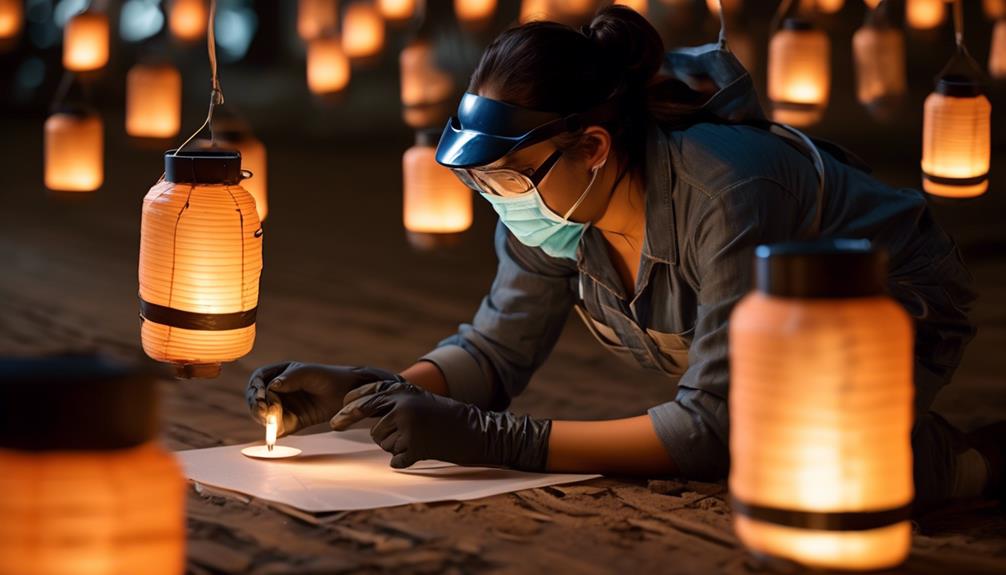
Prior to launching the floating paper lantern, it is crucial to observe safety precautions and consider helpful tips to ensure a smooth and secure experience. When dealing with fire safety, it's important to keep a fire extinguisher or a bucket of water nearby in case of emergencies. Additionally, choose a launch site that is clear of trees, buildings, or any other flammable objects. Wind resistance is another important factor to consider. Always check the weather forecast and avoid launching the lantern in strong winds, as it can lead to uncontrollable flight paths.
To ensure a safe and enjoyable experience, here are some essential safety precautions and tips to keep in mind:
| Safety Precautions and Tips |
|---|
| 1. Keep a fire extinguisher or a bucket of water nearby. |
| 2. Choose a launch site clear of flammable objects. |
| 3. Check the weather forecast and avoid launching in strong winds. |
| 4. Use flame-retardant materials for the lantern. |
| 5. Ensure the fuel source is securely attached to the lantern. |
Frequently Asked Questions
Can I Use a Different Type of Fuel Source for My Floating Paper Lantern?
We've found that there are different fuel options for floating paper lanterns, but safety precautions are crucial.
It's important to consider the type of fuel you'll be using and ensure it's safe for outdoor use. Keep in mind the potential fire hazards and choose a fuel that burns cleanly and steadily.
Always prioritize safety when experimenting with different fuel sources for your floating paper lantern.
What Are Some Common Mistakes to Avoid When Assembling the Lantern?
When assembling the lantern, it's crucial to avoid common mistakes like using flammable materials or overfilling it with fuel.
To ensure safety, always double-check the stability of the structure and never leave the lantern unattended once lit.
For successful assembly, pay attention to lighting techniques and maintain a safe distance from any obstructions.
These assembly tips will help create a beautiful and safe floating paper lantern experience.
How Long Does the Fuel Source Typically Last Once Ignited?
Once ignited, the typical duration of the fuel source in our lanterns is around 10-15 minutes. We recommend using a long-reach lighter or a candle to ignite the fuel cell, ensuring a safe and controlled process.
It creates a beautiful and serene spectacle, perfect for intimate gatherings or peaceful evenings. Our lanterns are designed to bring joy and tranquility, providing a magical experience that lasts just long enough to capture the moment.
Can I Reuse My Floating Paper Lantern, or Is It a One-Time Use Item?
Absolutely, you can reuse floating paper lanterns with caution. When considering alternative fuels, prioritize safety and environmental impact.
Always follow safety precautions and ensure the lantern is in good condition before reuse. Be mindful of the environmental impact and choose eco-friendly fuel sources.
With proper care and attention, you can extend the use of your floating lanterns while being mindful of safety and environmental concerns.
Are There Any Specific Environmental Considerations to Keep in Mind When Launching a Floating Paper Lantern?
When launching a floating paper lantern, it's vital to consider fire safety and use biodegradable materials. We should be mindful of wildlife impact and potential water pollution.
It's important to create an intimate connection with nature and ensure our actions don't harm the environment. As we embark on this beautiful tradition, let's embrace the alluring glow while being responsible stewards of the natural world.
Conclusion
As we release our floating paper lantern into the night sky, the warm glow illuminates the surrounding area, creating a magical and serene atmosphere.
The gentle flicker of the flame dances in the air, carrying our hopes and dreams with it.
With careful planning and attention to detail, our handmade creation has become a symbol of beauty and inspiration, floating gracefully into the unknown, leaving an unforgettable impression on all who witness its journey.
- About the Author
- Latest Posts
Introducing Ron, the home decor aficionado at ByRetreat, whose passion for creating beautiful and inviting spaces is at the heart of his work. With his deep knowledge of home decor and his innate sense of style, Ron brings a wealth of expertise and a keen eye for detail to the ByRetreat team.
Ron’s love for home decor goes beyond aesthetics; he understands that our surroundings play a significant role in our overall well-being and productivity. With this in mind, Ron is dedicated to transforming remote workspaces into havens of comfort, functionality, and beauty.
Architecture Home Styles
Choosing Vibrant Italian Colors for Your Architecture: A How-To Guide
Immerse yourself in the allure of Italian hues and discover how to infuse your architecture with vibrant colors that evoke the essence of Italy's design legacy.

When it comes to selecting vibrant Italian colors for your architecture, there's a saying that goes, 'In Rome, do as the Romans do.' We know the importance of capturing the essence of Italian design through color choices that speak to the heart of this rich cultural heritage.
From the warm hues of Tuscany to the captivating shades of Venice, our guide will walk you through the intricacies of infusing your architectural spaces with the vibrancy and sophistication that define Italian aesthetics. Join us as we unravel the secrets of incorporating these timeless hues into your design palette for an authentic touch of Italian charm.
Key Takeaways
- Blend vibrant Italian colors with timeless elegance for authentic architecture.
- Incorporate traditional hues like terracotta and green to evoke Italy's charm.
- Create a cozy atmosphere with nature-inspired neutrals as a serene backdrop.
- Balance vibrant hues like celeste and Rosa Schiaparelli with neutral tones for Italian charm.
Exploring Italian Color Palettes
Exploring the vibrant and diverse Italian color palettes reveals a rich tapestry of hues, from the pale turquoise of celeste to the bold shocking pink of rosa Schiaparelli, each contributing to the sophisticated charm of Italian architecture.
The blues of Italy, like celeste, evoke a sense of tranquility and elegance, reminiscent of the clear Mediterranean skies that grace the Italian coastline. This color, often associated with Bianchi bicycles, not only adds a touch of history but also embodies the essence of La Bella Figura, a concept deeply ingrained in Italian culture.
Rosa Schiaparelli, with its vibrant and daring personality, injects a sense of drama and modernity into Italian color schemes. Introduced by Elsa Schiaparelli, this shocking pink hue symbolizes creativity and individuality, reflecting the innovative spirit of Italian design.
As we delve into the depths of Italian color palettes, we encounter Verde Veronese, a deep green inspired by Paolo Veronese, exuding a sense of sophistication that aligns perfectly with the artistic heritage of Italy.
Selecting Authentic Italian Hues
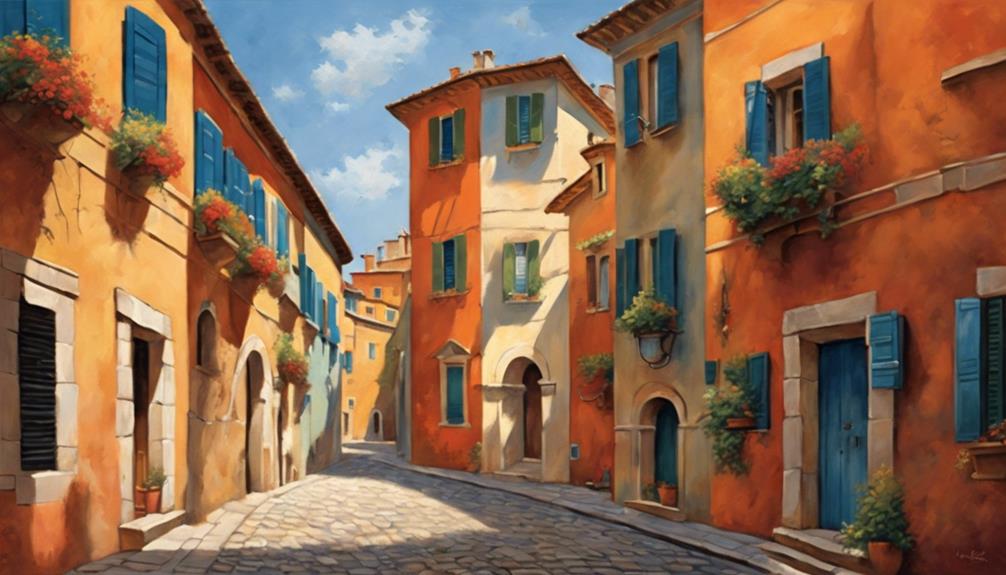
When considering authentic Italian hues for architecture, our choices encompass a vibrant spectrum of colors that reflect the country's rich cultural heritage and natural beauty. The Italian color palette is a blend of history, fashion, and the Mediterranean look, offering a unique and timeless appeal.
Here are three essential hues to consider:
- Terracotta: A quintessential Italian color, terracotta captures the essence of Italy with its warm orange tones. It symbolizes the country's rustic charm and historical significance, often seen in the architecture of Tuscany and Sicily.
- Nature-Inspired Neutrals: Warm whites, soft beiges, and earthy taupes create a serene backdrop in Italian spaces, echoing the natural beauty of the Italian landscape. These hues provide a sense of tranquility and elegance, perfect for achieving an authentic Italian ambiance.
- Green, Pink, and Teal: These colors bring elements of nature and Mediterranean flair into Italian architecture, infusing spaces with a refreshing vitality. Inspired by the lush Italian countryside and coastal waters, these hues add vibrancy and a touch of sophistication to any design.
Incorporating Vibrant Tones
Let's infuse our architectural designs with the vibrant hues of Italy, incorporating colors like celeste, rosa, and verde Veronese for an authentic and lively aesthetic.
To bring a touch of ancient Rome to your architecture, consider using sky blue accents reminiscent of the clear Italian skies. Integrate blue tiles into your design to evoke a sense of Mediterranean charm, reminiscent of the azure waters that surround the Italian coast.
For a bold and striking look, experiment with iron oxide to add depth and intensity to your color palette. These Italian colors can transport your architecture to a place where history and modernity blend seamlessly.
Infusing Italian Charm in Architecture
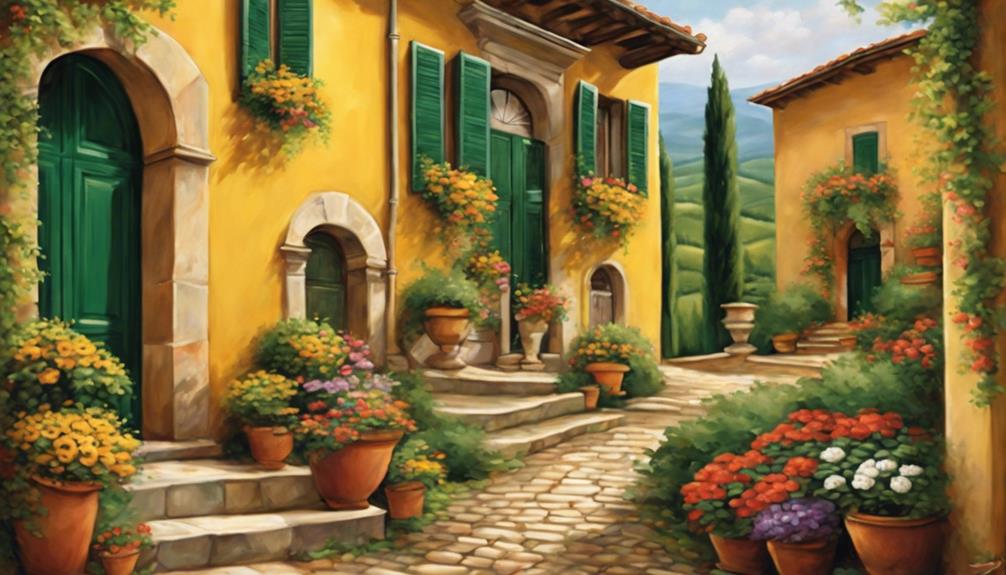
Our architectural canvas comes alive as we infuse it with the vibrant colors of Italy, painting a picture of charm and elegance reminiscent of the Mediterranean allure. When considering infusing Italian charm into architecture, several colors come to mind, each carrying a historical and cultural significance dating back to ancient times. Embracing the national colors of Italy can elevate the design to evoke a sense of La Dolce Vita, capturing the essence of the Italian way of life. Here are three key elements to consider when infusing Italian charm into architecture:
- Terracotta: This warm earthy tone symbolizes the Italian countryside and is often used in facades and roofs, bringing a rustic yet inviting feel to the architecture.
- Green: Reflecting the lush landscapes of Italy, green hues can be incorporated through elements like shutters, balconies, and landscaping, adding a touch of freshness and vitality to the design.
- Pink: Soft pink shades reminiscent of Mediterranean sunsets can be used to create a romantic and charming atmosphere, especially when paired with white accents for a classic Italian look.
Tips for a Dolce Vita Design
Embracing the essence of Dolce Vita in your architectural design involves a harmonious blend of vibrant Italian colors and timeless elegance. To achieve a design that exudes the warm and inviting feel of Italy, consider incorporating traditional Italian colors such as terracotta, nature-inspired neutrals, green, pink, and teal. These hues create a cozy atmosphere that welcomes all who enter.
For a more sophisticated vibe, infuse your design with colors like celeste, Rosa Schiaparelli, Verde Veronese, Terra di Siena, and Giallo Napoli. These traditional Italian colors add a touch of luxury and elegance to your space, setting the stage for a truly luxurious ambiance.
To capture the spirit of Italy's landscapes and culture, don't shy away from using vibrant Italian colors that mirror the beauty of the country. Balance these vibrant hues with neutral tones like cream, white, and earthy shades to create a space that reflects the charm of Italian living. Let your architecture speak the language of Italy through a thoughtful selection of colors that evoke the spirit of Dolce Vita.
Frequently Asked Questions
What Are Traditional Italian Colors?
We adore traditional Italian colors like celeste, rosa, verde, terra di Siena, and giallo Napoli. Each hue tells a tale of artistry and cultural richness. Italy's vibrant palette, steeped in history, captivates with its timeless allure.
What Is the Favorite Color of Italians?
Blue is quintessential for Italians, embodying the sky and sea. Azzurro, a cherished hue, mirrors sunny days. It's woven into Italian life, from sports to architecture. Reflecting coastal allure, blues imbue peace and nature's embrace.
What Color Palette Does Italian Interior Design Use?
In Italian interior design, we embrace a color palette inspired by nature. From warm whites to rich olive greens, we aim for a tranquil atmosphere with minimal contrasts. Soft sage and teal hues bring the beauty of the Italian landscape indoors.
What Are the Colors Inspired by Italy?
Inspired by Italy, colors like Terracotta, Nature-Inspired Neutrals, Green, Pink, and Teal captivate with warmth, calm, balance, and romance. These hues infuse spaces with Mediterranean allure, evoking landscapes in vibrant splendor.
Conclusion
As we navigate the colorful palette of Italian architecture, let's remember that each hue tells a story, like notes in a symphony.
Just as a master painter blends shades to create a masterpiece, so too can we blend vibrant Italian colors to evoke a sense of beauty and harmony in our architectural designs.
Let's paint our spaces with the rich history and cultural heritage of Italy, creating a tapestry of elegance and sophistication for all to admire.
- About the Author
- Latest Posts
Introducing Ron, the home decor aficionado at ByRetreat, whose passion for creating beautiful and inviting spaces is at the heart of his work. With his deep knowledge of home decor and his innate sense of style, Ron brings a wealth of expertise and a keen eye for detail to the ByRetreat team.
Ron’s love for home decor goes beyond aesthetics; he understands that our surroundings play a significant role in our overall well-being and productivity. With this in mind, Ron is dedicated to transforming remote workspaces into havens of comfort, functionality, and beauty.
-

 Vetted3 weeks ago
Vetted3 weeks ago15 Best Leather Restorer Products to Revive Your Furniture and Accessories
-

 Vetted2 weeks ago
Vetted2 weeks ago15 Best Contact Paper for Kitchen Cabinets to Elevate Your Home Decor
-

 Vetted3 weeks ago
Vetted3 weeks ago15 Best Leg Massagers to Relieve Tension and Improve Circulation – Ultimate Guide
-

 Vetted4 weeks ago
Vetted4 weeks ago14 Best Lawn Tractors of 2024 – Ultimate Guide for Your Yard Maintenance
-

 Vetted2 weeks ago
Vetted2 weeks ago15 Best Drain Snakes to Unclog Your Pipes Like a Pro
-

 Vetted4 weeks ago
Vetted4 weeks ago15 Best Commercial Backpack Vacuums for Efficient Cleaning Tasks
-

 Vetted3 weeks ago
Vetted3 weeks ago15 Best Lawn Games for Adults to Elevate Your Outdoor Gatherings
-

 Vetted4 weeks ago
Vetted4 weeks ago15 Best Group Games for Adults to Spice Up Your Next Gathering

























